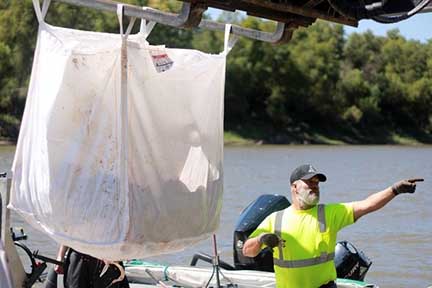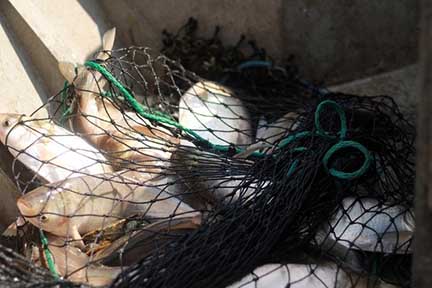KANSAS CITY, Mo. – A successful invasive carp removal project on the lower Grand River by the Missouri Department of Conservation (MDC) provides hope for future similar projects. MDC and the U.S. Fish and Wildlife Service (USFWS) used nets and electrofishing Sept. 12-16 to remove almost 25,000 pounds of non-native carp from the lower eight miles of the river. The project improved the river habitat for native fish and provided information for how commercial operations might be used in the future to reduce invasive carp. A commercial fishing business will market the fish caught during this operation.

Almost 25,000 pounds of carp removed for both management and research
“We were able to run very smooth and efficiently,” said Kasey Whitman, MDC Missouri River and Biometrics Unit supervisor. “The weather and the river cooperated.”
Invasive carp reproduce prolifically and grow quickly, taking up space in the water and reducing the food base for native fish, including sport fish. Fish removal projects cannot eliminate them from the rivers. But if commercial fishing operations can profitably remove carp, then that is one way the numbers of invasive fish can be reduced, and conditions improved for native fish. Commercial fishing is allowed in the Missouri River, Mississippi River, and St. Francis River. However, under special permits it can be allowed in non-commercial waters. The commercial fishing operator plans to process the Grand River carp caught to sell as catfish, crayfish, and lobster bait.
During the operation, MDC had 76 employees and the USFWS had 12 operating various types of equipment on boats and on shore. Nets blocked off the lower eight miles of the Grand River before its confluence with the Missouri River. A combination of gill nets and various types of electrofishing gear was used to capture carp. Since this was also a research project, every invasive carp was counted with a final tally of 6,716 fish. More than 95 percent were silver carp. Some grass carp and a few bighead carp were also caught. Sub samples of invasive carp were weighed and measured for ongoing research.
MDC has done fish population studies for the river and those will be ongoing to measure the long-range effects of invasive fish removal.
The average size of the silver carp caught was three to four pounds. Those are fish that are two to three years old and are on the borderline to becoming sexually mature. So, removing them can help limit future spawns of invasives.
One surprise, Whiteman said, is that more paddlefish were caught than expected. All native fish caught were weighed, measured, and released unharmed outside the project zone. Most of the native fishes caught were buffalo, carp suckers, and shad. The sampling equipment was mostly effective in the upper water columns used by invasive carp and did not net deeper dwelling catfish.
The information gathered will be used to guide future operations. If commercial invasive carp removal becomes feasible in the future, the operators under current regulations would only be allowed to use hoop nets, seines, gill nets, and trammel nets, Whiteman said. In the coming months, the USFWS will be using sophisticated sonar gear to measure how quickly invasive carp move back into the lower Grand River.

MDC and the U.S. Fish and Wildlife Service recently removed 25,000 pounds of invasive carp from the lower Grand River. The project was part fisheries management, but also a research project to pioneer new ways of managing invasive carp in the Missouri and Mississippi River systems.
MDC appreciates the Grand River angling community for their patience and support for the project and the temporary access and river closing, Whiteman said. The project was another step towards managing invasive carp in the Missouri and Mississippi River systems.
“It’s a knowledge gain and learning so we can strategize for the future,” he said.
To learn more about invasive carp, visit https://short.mdc.mo.gov/4Tr.
